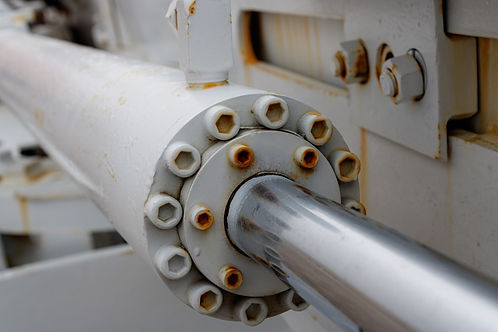
Hydraulics: Beginner's Guide
Craig Thomas
29 Nov 2024
Explore the fundamentals of hydraulic systems with this easy-to-follow guide. Learn about key components, how they work together, and their applications in various industries. Perfect for beginners looking to understand the power of hydraulics!

What is hydraulics?
Hydraulics is the science of using pressurized fluid to transmit force and perform work. A hydraulic system typically consists of pumps, actuators, valves, and fluid, all working together to move, lift, or control machinery and equipment. The force generated by hydraulic fluid can be incredibly powerful, which is why hydraulic systems are commonly used in industries such as construction, agriculture, manufacturing, and automotive.
Basic Principles of Hydraulics
Hydraulic systems work on Pascal’s Law, which states that:
Pressure exerted on a fluid is transmitted equally in all directions.
This principle allows hydraulics to achieve high forces with relatively low input energy. By applying a small force over a small area, we can create a larger force over a larger area.

Key Components of a Hydraulic System
Hydraulic Fluid
The lifeblood of any hydraulic system, fluid is used to transmit power. It also helps with lubrication, cooling, and preventing rust.
Common types include mineral oils, water-based fluids, and synthetic fluids.
Pump
The pump draws fluid from the reservoir and pushes it into the system under pressure.
Types of pumps include gear pumps, piston pumps, and vane pumps.
Hydraulic Cylinder (Actuator)
Converts the pressurized fluid into mechanical motion (linear motion), typically to move loads or equipment.
Single-acting cylinders have one port, while double-acting cylinders use two ports for extending and retracting.
Valves
Control the flow, pressure, and direction of the hydraulic fluid in the system.
Types include check valves, directional control valves, and pressure relief valves.
Reservoir
Stores the hydraulic fluid and helps with cooling and filtration.
Reservoirs ensure that fluid is always available for the pump and prevent air from entering the system.
Hoses and Fittings
Used to carry fluid between the different components of the hydraulic system.
Must be capable of handling high pressure without leaking or bursting.
How Hydraulics Work: A Step-by-Step Process
Let’s break down the flow of a typical hydraulic system:
Fluid is drawn into the pump from the reservoir.
The pump uses mechanical energy (typically from an electric motor) to pressurize the fluid.
Pressurized fluid flows into the hydraulic cylinder or motor through hoses, valves, and fittings.
The fluid pushes the piston inside the cylinder, creating force that performs work, such as lifting a load or moving a piece of equipment.
Fluid returns to the reservoir after passing through the actuator and valves.
The valves control the flow and direction of the fluid, ensuring that the correct part of the system is activated at the right time.
Fluid is filtered to remove contaminants and prevent damage to the system.

Types of Hydraulic Systems
Hydraulic systems come in a variety of designs depending on their application. Below are the common types:
Open Loop Systems
In this system, the fluid is drawn from a reservoir and pumped into the system, then returned to the reservoir after use. It’s often used in low-pressure applications.
Example Application: Construction machinery such as diggers.
Closed Loop Systems
Here, the fluid is continuously circulated within the system, which is more efficient for high-performance machinery.
Example Application: Agricultural machinery like tractors.
Hydraulic System Applications
Hydraulic systems are used in many industries for a wide range of tasks. Here are a few common applications:
Construction
Hydraulic excavators, backhoes, and cranes utilize hydraulic cylinders to lift heavy loads and dig deep into the earth.
Agriculture
Tractors, harvesters, and ploughs employ hydraulic systems to lift and adjust attachments, such as ploughs and mowers.
Manufacturing
Hydraulic presses are used for stamping, forming, and cutting metal parts in factories.
Aerospace
Aircraft rely on hydraulic systems for landing gear operation, brakes, and wing control surfaces.
Automotive
Hydraulic brakes and steering systems enhance vehicle performance and safety.
Marine
Hydraulic systems manage steering, winches, and stabilizers on boats and ships.
Mining
Hydraulic drills and shovels are crucial for excavating and transporting materials.
Robotics
Hydraulic actuators power robotic arms and machinery for precision tasks.
Energy
Hydraulic systems play a key role in oil and gas extraction, as well as renewable energy applications like wind turbines.
Maintenance and Troubleshooting Tips
Regular Fluid Checks
Always ensure the hydraulic fluid is clean and at the correct level to prevent system failure. Dirty or low fluid can cause components to wear out prematurely.
Check for Leaks
Regularly inspect hoses, fittings, and cylinders for signs of leaks. Even small leaks can lead to major efficiency losses or system failures.
Monitor System Pressure
Keep an eye on pressure gauges to ensure the system operates within the recommended pressure range. Too high or too low pressure can cause performance issues or damage.
Change Filters Regularly
Filters should be replaced at recommended intervals to prevent contamination build-up in the hydraulic fluid.
Conclusion
Hydraulics is a fascinating and powerful technology that has transformed how we handle heavy lifting, precise movements, and high-power applications in various industries. By understanding the basic components and principles behind hydraulic systems, beginners can start designing, maintaining, and troubleshooting hydraulic systems more effectively.By familiarising yourself with these fundamental concepts, you’ll be better equipped to take full advantage of hydraulic technology, whether you're designing systems, maintaining equipment, or troubleshooting issues.
Need Expert Assistance?
Our team of technical specialists is here to help. If you have questions or need further guidance, feel free to contact us. . For more insights, check out our blog.